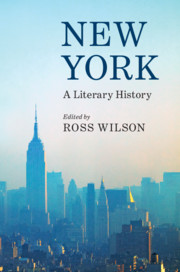Book contents
- New York: A Literary History
- New York
- Copyright page
- Contents
- Contributors
- Acknowledgements
- Chapter 1 Introduction
- Part I Adaptation and Adjustment
- Part II Innovation and Inspiration
- Part III Identity and Place
- Chapter 10 Growing Up in Manhattan
- Chapter 11 Wartime Reading in the City, 1914–1918
- Chapter 12 The Periodical and the Flâneur in Early New York Writing
- Chapter 13 Multiple Voices
- Chapter 14 The New York School?
- Part IV Tragedy and Hope
- Bibliography
- Index
Chapter 14 - The New York School?
Towards a Definition
from Part III - Identity and Place
Published online by Cambridge University Press: 19 February 2020
- New York: A Literary History
- New York
- Copyright page
- Contents
- Contributors
- Acknowledgements
- Chapter 1 Introduction
- Part I Adaptation and Adjustment
- Part II Innovation and Inspiration
- Part III Identity and Place
- Chapter 10 Growing Up in Manhattan
- Chapter 11 Wartime Reading in the City, 1914–1918
- Chapter 12 The Periodical and the Flâneur in Early New York Writing
- Chapter 13 Multiple Voices
- Chapter 14 The New York School?
- Part IV Tragedy and Hope
- Bibliography
- Index
Summary
This chapter examines the development of the New York School of Poetry. This particular “school” or movement has, since its inception, had to do with people meeting, rubbing off on, knowing, collaborating with, being inspired by, and most of all–talking–to other people, many of whom happened to be artists and poets. By this definition, it follows that the school began at the moment in which John Ashbery met Kenneth Koch, or Frank O’Hara, in 1946 and 1949 respectively, depending on whose influence on whom you take to be more generative. The New York School, has been shaped sometimes subtly and sometimes undeniably–by many other deeply involved figures at various points in its evolution, while also consistently consisting of a poetry that explores and creates poetic forms which are distinct in their slipperiness and reflexivity; as they register, among other things, the urban built environment from which they have been written.
- Type
- Chapter
- Information
- New YorkA Literary History, pp. 194 - 212Publisher: Cambridge University PressPrint publication year: 2020

